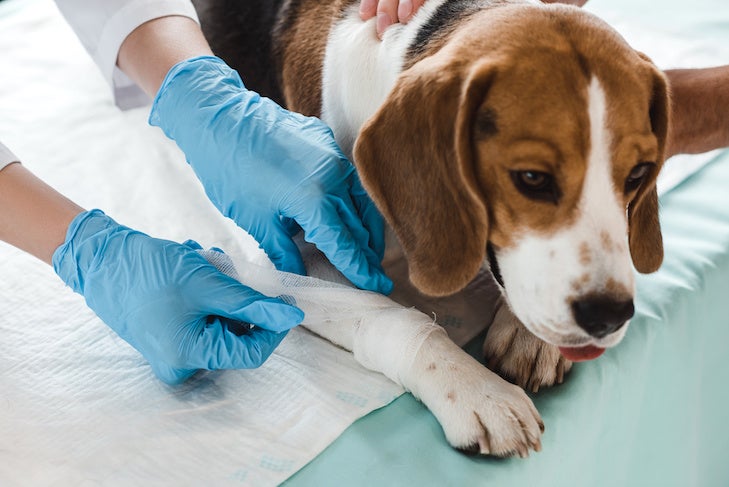Occasional paw licking is normal grooming behavior in dogs. However, when the licking is extreme and persistent, it’s usually a sign there’s an underlying problem. If your dog’s paws also look red or inflamed, they could have pododermatitis.
The key to getting pododermatitis in dogs under control is prompt diagnosis and treatment of the underlying cause. Otherwise, it can lead to debilitating chronic flare-ups and infections.
What is Pododermatitis in Dogs?
Dr. Millie Rosales is a board-certified veterinary dermatologist. She explains that pododermatitis is a broad medical term for inflammation of the skin of the paw. The inflammation can affect one or multiple paws and can cover a part or the whole of the paw. “It can be the paw, the digits, around the nail, or the pads,” Dr. Rosales says.
What Causes Pododermatitis in Dogs?
One of the biggest challenges of pododermatitis is that it can be multifactorial. There’s always a primary underlying cause for pododermatitis. But other factors can also influence the inflammation.

Primary Causes of Pododermatitis in Dogs
“It’s important to understand that there are many causes of pododermatitis,” Dr. Rosales says.
Sometimes, the primary cause is obvious. In other cases, it’s more subtle and requires careful diagnostic work. Some dogs can also have more than one primary cause, making it trickier to get pododermatitis under control. It’s also important to determine if only one or multiple of a dog’s paws are affected.
Dr. Rosales explains that a common cause for paw inflammation is allergies, whether that’s to food or atopy, which is an allergen in the environment like pollen from trees, grass, weeds, etc.). “Those allergies will cause the dog to have very itchy feet, and the chewing and licking leads to trauma and often infection,” she says.
Some other causes of pododermatitis in dogs include:
-
Mange
-
Autoimmune disorders, such as pemphigus foliaceous or pemphigus vulgaris
-
Hormonal disorders, such as hypothyroidism or Cushing’s disease
-
Metabolic disorders and hepatic cutaneous syndrome
-
Nutritional disorders, such as zinc deficiencies
-
Fungal infections, such as ringworm
-
Parasites, such as hookworms
-
Foreign bodies, such as foxtail grass seed heads, splinters, or glass. This is only a common cause when one paw is affected.
-
Behavioral issues, such as compulsive disorders or anxiety
-
Leishmania
-
Cancer
Secondary Factors
Dr. Rosales explains that the first time a veterinarian will see a dog relating to pododermatitis is often when a secondary bacterial or fungal yeast infection occurs. The altered microenvironment of the skin, along with the dog’s desire to chew and lick their inflamed paws, mean infections are common.
Infection can affect one or multiple paws. Sometimes, different types of infection affect different paws, and the infection can be superficial or deep.
Predisposing Factors

Predisposing factors promote the risk of a dog developing pododermatitis. Dr. Rosales explains that certain breeds, such as Bulldogs, Mastiffs, and other bully breeds, are more prone to allergies or obesity that can contribute to paw inflammation, but their overall conformation is also problematic.
They might have webbed paws or thickened pads and bear weight differently. Interdigital cysts and interdigital furunculosis (lesions or lumps) are common problems that can lead to deep and chronic infections. “These cases are really challenging to manage because we can’t change how these dogs are genetically built,” Dr. Rosales says.
Any dog with altered weight-bearing is more likely to have paw inflammation. This includes large breeds, obese dogs, and those with arthritis or orthopedic problems.
Perpetuating Factors
Perpetuating factors exacerbate and maintain pododermatitis symptoms, worsening the inflammation and secondary problems. This might include scarring, lesions, ingrown hairs, changes in pad formation and how the dog bears weight, and chronic infections. These perpetuating factors can sometimes result in more serious ongoing problems and discomfort for the dog than the primary cause of pododermatitis. Speedy diagnosis and treatment of the primary and secondary causes can help minimize problematic perpetuating factors from causing long-term complications.
Signs of Pododermatitis in Dogs
Dr. Rosales explains that the most common sign to watch out for in a dog with pododermatitis is licking and chewing the paws, as this suggests itchiness and discomfort. The paws may also be red. “A dog owner may not think to separate and look between the toes for signs of inflammation,” she says. “Then it can get worse from there, where the dog has bleeding, ulcerated, crusty, cracking, swollen paws, and it hurts to walk.”
Other possible signs include:
-
Hair loss
-
Hyperpigmentation (the formation of dark patches on the skin)
-
Brown saliva stains on the hair around the paw
-
Thickening of the skin or pads
-
Draining tracts
-
Scaling
-
Lameness
-
Poor appetite
-
Lethargy
If your dog starts licking or chewing their paws a lot, don’t delay seeking advice from a veterinarian. Waiting can result in difficult-to-treat infections and other perpetuating factors.

How is Pododermatitis in Dogs Diagnosed?
Establishing the underlying cause of pododermatitis requires a methodical approach. This typically involves your veterinarian taking a detailed medical history, conducting a thorough physical exam, and running diagnostic tests. Dr. Rosales wants to know when the owner first noticed the problem, whether it started in one paw or all four, and if it’s symmetrical. Your veterinarian might also ask about other pets in the household, where your dog exercises, their diet, and if they’re on any medication.
The history and physical exam help your veterinarian decide which route to go down regarding testing. “If the dog is 10 years old and has never had a foot problem and now has these crusty, awful feet, I wouldn’t be too worried about allergies,” Dr. Rosales says. In these instances, an autoimmune or hormonal disorder is more likely.
Dr. Rosales explains that testing can be multifaceted, but typically involves taking skin samples. This might include hair plucking, scrapings, or fine needle aspirations. These samples help detect infections, cancer, and other primary and secondary causes. “Sometimes, I have to take a biopsy of different areas on the foot so that it can give me an idea of what’s going on,” Dr. Rosales says. If the pododermatitis affects more than one paw, samples may need to be taken from each to establish if they have different infections.
Blood work and endocrine analysis to detect hormonal or autoimmune disorders or X-rays to detect foreign bodies might be on the diagnostic list. If your veterinarian suspects allergies, they may suggest a food trial or allergy testing.
How to Treat Pododermatitis in Dogs
Treatment for pododermatitis is usually two–pronged. Your veterinarian will deal with any secondary infection and establish a treatment plan for the primary cause.
Treating Secondary Causes
“There’s a high likelihood your dog will get a secondary bacterial or yeast infection,” Dr. Rosales says. “It’s important to treat that because this causes a lot of the itchiness, inflammation, and pain the pet is feeling.” Immediately treating any infection removes the risk of it worsening and can offer comfort to your dog while working on a treatment plan for the primary cause of the pododermatitis.
Typically, treating any secondary infection involves administering antibiotics and sometimes antifungal medication.

Treating Primary Causes
Because there are so many primary causes of pododermatitis, treatment options vary greatly depending on the diagnosis. It could involve individual or combination drug therapies, topical creams, pain management, anti-itch medications, lifestyle changes, special gear (such as boots when it relates to a confirmation issue), and possibly surgery for the removal of foreign bodies or cancer diagnoses. Some treatments will be temporary, and others might be lifelong.
For some food and contact hypersensitivities, avoiding ingestion or contact with the allergens is possible. “If it’s a pollen allergy, then I need to put the pet on some allergy medicine to stop it from chewing and licking its paw,” Dr. Rosales says. Antihistamines, oral antibiotics, and regular foot baths with special medicated shampoo can make a big difference in managing the symptoms and discomfort. Immunotherapy treatment and hyposensitization vaccines are other avenues your veterinarian might explore depending on the type and severity of the allergy.
Surgery may be considered as a last resort when the pododermatitis results in changes to the paw that cause ongoing discomfort. However, Dr. Rosales recommends alternative management strategies as the surgery is complex and often leads to postoperative complications and potential further conformational issues. Plus, the inflammation can still reoccur.
Pododermatitis in Dogs Prognosis
“The prognosis really depends on the underlying cause,” Dr. Rosales says. Fortunately, for the most common cause, she says the prognosis is pretty good because it’s possible to manage allergic diseases. A positive outcome is also typical for pododermatitis caused by things like foreign bodies, parasitic diseases, or nutritional disorders.
For some disorders and diseases, such as cancer, the prognosis isn’t so good. “There’s also a metabolic disorder called hepatic cutaneous syndrome, and that’s a really bad disease that has a poor prognosis,” Dr. Rosales says. When pododermatitis causes severe damage to the paws, this can result in recurrent problems that require lifelong care. The pododermatitis may also require continual management when it relates to conformational issues or serious autoimmune conditions.







